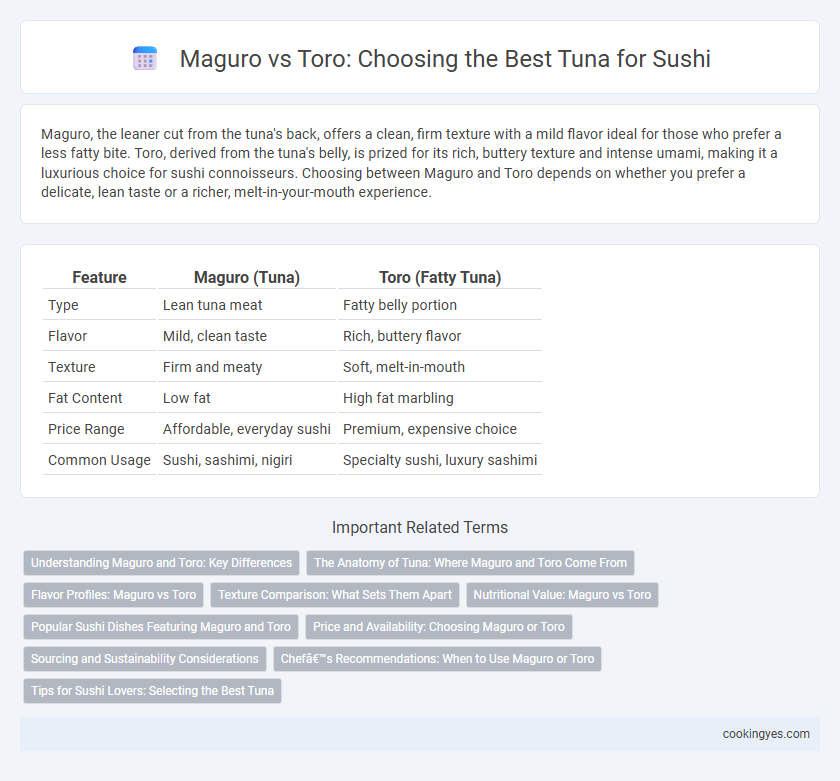Maguro, the leaner cut from the tuna's back, offers a clean, firm texture with a mild flavor ideal for those who prefer a less fatty bite. Toro, derived from the tuna's belly, is prized for its rich, buttery texture and intense umami, making it a luxurious choice for sushi connoisseurs. Choosing between Maguro and Toro depends on whether you prefer a delicate, lean taste or a richer, melt-in-your-mouth experience.
Table of Comparison
| Feature | Maguro (Tuna) | Toro (Fatty Tuna) |
|---|---|---|
| Type | Lean tuna meat | Fatty belly portion |
| Flavor | Mild, clean taste | Rich, buttery flavor |
| Texture | Firm and meaty | Soft, melt-in-mouth |
| Fat Content | Low fat | High fat marbling |
| Price Range | Affordable, everyday sushi | Premium, expensive choice |
| Common Usage | Sushi, sashimi, nigiri | Specialty sushi, luxury sashimi |
Understanding Maguro and Toro: Key Differences
Maguro and Toro are distinct cuts of tuna prized in sushi cuisine, with Maguro referring to the leaner, red meat from the tuna's body and Toro indicating the fatty belly portion known for its rich texture. Toro is further divided into Otoro, the fattiest and most prized belly cut, and Chutoro, which balances fat and lean meat, offering a buttery taste that contrasts with Maguro's firmer flesh and mild flavor. Choosing between Maguro and Toro depends on preference for texture and richness, where Maguro delivers a clean, meaty experience and Toro offers decadence through its marbled fat content.
The Anatomy of Tuna: Where Maguro and Toro Come From
Maguro refers to the lean red meat from the tuna's main body muscles, prized for its firm texture and rich flavor. Toro originates from the fatty belly portion, with Otoro being the fattiest and most luxurious cut, offering a melt-in-the-mouth experience due to its high omega-3 fat content. Understanding the anatomical differences highlights why Maguro is favored for its clean taste, while Toro is sought after for its buttery richness and tenderness.
Flavor Profiles: Maguro vs Toro
Maguro offers a leaner texture with a clean, mild flavor distinguished by its subtle umami notes, appealing to those who prefer a lighter tuna taste. Toro, especially otoro, boasts a rich, buttery texture with intense marbling, delivering a creamy, melt-in-the-mouth experience that highlights a deep, fatty umami profile. The contrast in fat content between Maguro and Toro dramatically influences their flavor intensity and mouthfeel, making Toro a prized choice for luxury sushi enthusiasts seeking indulgence.
Texture Comparison: What Sets Them Apart
Maguro features a firm, lean texture with a clean bite that highlights its mild flavor, while Toro offers a rich, buttery mouthfeel due to its higher fat content, creating a melt-in-your-mouth experience. The contrast in texture stems from Toro's marbled fat, which provides a softer, more delicate consistency compared to Maguro's denser flesh. This textural difference significantly influences sushi selection, catering to preferences between a satisfying chew and velvety richness.
Nutritional Value: Maguro vs Toro
Maguro, or lean tuna, offers a high-protein, low-fat option rich in vitamin B12 and selenium, making it ideal for those seeking a nutrient-dense choice with fewer calories. Toro, the fatty belly portion of tuna, contains higher levels of omega-3 fatty acids and vitamin D, supporting heart health and anti-inflammatory benefits while providing a richer, buttery texture. Selecting between maguro and toro depends on balancing protein intake with healthy fats, catering to dietary goals focused on lean nutrition versus essential fatty acid consumption.
Popular Sushi Dishes Featuring Maguro and Toro
Maguro, commonly known as lean tuna, is a staple in sushi dishes like Tekka Maki and Maguro Nigiri, prized for its firm texture and rich umami flavor. Toro, the fatty belly portion of the tuna, is celebrated for its buttery texture and melts in the mouth, often featured in premium sushi such as Otoro Nigiri and Chu-Toro rolls. Both Maguro and Toro provide distinct taste experiences, making them essential in classic and luxurious tuna sushi preparations.
Price and Availability: Choosing Maguro or Toro
Maguro, commonly known as lean tuna, is more affordable and widely available in sushi restaurants due to its higher abundance. Toro, the prized fatty belly portion of tuna, commands a premium price because of its limited availability and rich, buttery texture. Selecting between Maguro and Toro depends on budget considerations and the desired flavor intensity, with Toro being a luxury choice and Maguro offering a cost-effective yet satisfying alternative.
Sourcing and Sustainability Considerations
Maguro, sourced primarily from lean yellowfin or bluefin tuna, offers a sustainable choice when harvested from well-managed fisheries adhering to catch limits and seasonal regulations. Toro, the prized fatty belly cut, often comes from bluefin tuna, a species vulnerable to overfishing, making strict sourcing from certified sustainable suppliers essential to protect tuna populations. Opting for Maguro from MSC-certified fisheries or choosing Atlantic bluefin from quota-controlled environments supports responsible tuna aquaculture and fishery sustainability.
Chef’s Recommendations: When to Use Maguro or Toro
Chefs recommend using Maguro for sushi when a clean, firm texture and a lean flavor profile are desired, making it ideal for lighter, refreshing dishes. Toro, prized for its rich marbling and melt-in-mouth softness, is best reserved for indulgent, premium sushi experiences or special occasions. Selecting between Maguro and Toro depends on balancing lean versus fatty flavor preferences to enhance the overall sushi tasting.
Tips for Sushi Lovers: Selecting the Best Tuna
When selecting tuna for sushi, prioritize freshness and marbling to distinguish Maguro from Toro; Maguro offers a leaner, firmer texture, while Toro is prized for its rich, buttery fat content. Choose Toro cuts like Otoro or Chutoro for a melt-in-the-mouth experience, especially from trusted sources known for sustainable fishing practices. Always inspect the color and smell--vibrant red hues and a clean ocean scent signal premium quality tuna ideal for sushi enthusiasts.
Maguro vs Toro for Tuna Selection Infographic

 cookingyes.com
cookingyes.com